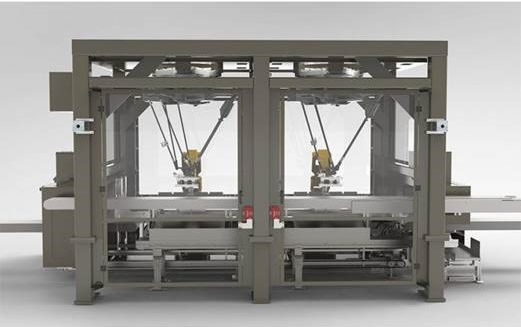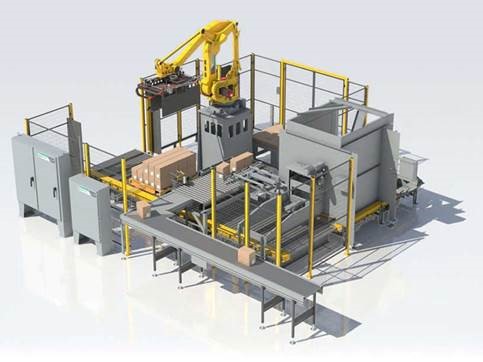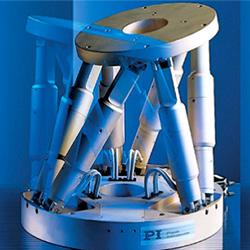Maximizing the capabilities of end-of-line packaging systems for handling medical devices depends upon how smoothly the disparate functions are integrated into a singular, optimized packaging line. Robotics and turnkey integration provide the solution.
 Optimizing Integration of End-of-Line Packaging Systems for Medical Devices
Optimizing Integration of End-of-Line Packaging Systems for Medical Devices

Bob Euteneuer, Medical Program Manager | Brenton Engineering a division of ProMach
The primary purpose of secondary packaging is to ensure the safety of a product during storage and transportation. The integrity of secondary packaging is particularly important with medical devices, where product safety is by far the most prevalent consideration for these mission-critical items.
The proper packaging, storage and distribution of medical devices enables healthcare professionals and patients access to high-quality medical equipment and instrumentation that perform as designed and manufactured. These medical devices range from simple tongue depressors, parenterals, test kits and blood glucose meters, to complex programmable pacemakers and artificial pancreas systems. According to the Food & Drug Administration (FDA), "A medical device is any article, instrument, apparatus or machine that is used in the prevention, diagnosis or treatment of illness or disease, or for detecting, measuring, restoring, correcting or modifying the structure or function of the body for some health purpose."
The FDA does not just monitor and control the manufacture of medical devices used in the United States, it also ensures the packaging used is safe and effective at keeping the contents clean and germ-free. The FDA expects its manufacturers to provide packaging that protects against environmental conditions, such as the transport and aging of the packaging material itself, which could weaken over time and expose the contents to pathogens.
The packaging must also meet rigorous labeling standards which let the FDA trace devices in use. Unique Device Identification (UDI) has become increasingly important in how manufacturers design and execute their packaging. A key component of the UDI is its Device Identifier (DI), which is unique to each model of the device. A separate component of the UDI is the Production Identifier (PI), which includes a device’s lot or batch number, serial number, expiration date and manufacturing date. Manufacturers must ensure the PI appears in a readable format, and in a format decipherable by machines, such as linear barcodes or RFID tags. These initiatives can require identification and authenticity features on both primary and secondary packaging.
Because of the life-critical nature of medical devices, these requirements demand a higher expectation of performance from end-of-line secondary packaging systems like case erectors, case packers, case sealers, labelers, palletizers and stretch wrappers, as well as the material handling systems that connect them.
For medical device manufacturing, end-of-line secondary-packaging systems must produce reliable and cost-effective results, while complying with FDA guidelines and the needs and stringent requirements of the healthcare and bioprocessing industries. This includes high-volume throughput, packaging flexibility, handling of delicate medical devices without damage, and maintaining industry standards for cleanliness and sterility. Each of these packaging systems should also be assessed by these additional factors: technical capabilities, labor requirements, worker safety, maintainability, serviceability, reliability, capital investment, floor space, energy requirements, ergonomics and return on investment.
Turnkey Integration of End-of-Line Packaging Systems
Maximizing the capabilities of these individual packaging systems depends upon how smoothly they are integrated into a singular, optimized packaging line.
Designing and integrating legislative-compliant, end-of-line solutions for medical device manufacturing – particularly when robotics are employed for pick-and-place case packing or palletizing – may appear as straightforward as acquiring and programming the machinery and robots. But in reality this is just the beginning. Programming is the easy part. Making the ancillary systems work together, and presenting the products to the individual systems and robots so they are not doing more work than is necessary can be challenging, requiring considerable expertise.
This expertise can be found exclusively with the end-of-line machinery OEMs, in terms of understanding the upstream and downstream inputs and outputs to the machines that will serve to optimize the entire end-of-line. The leading end-of-line machinery today has the latest in servo-motion control technology for fast and reliable changeovers, superior diagnostics for quick identification of root-cause issues, and first-rate technical support, all of which contribute to high-end overall equipment effectiveness (OEE) metrics. By comparison, system integrators, which are basically engineering and project management companies, can never match the knowledge and experience that OEM's have amassed on their end-of-line machinery applications.
As a standard practice, a turnkey integration encompasses examination of every system on the line, and evaluation of meantime between failure and how that affects productions rates. These risk assessments may lead to built-in accumulation lanes to ensure the line keeps moving during short periods of downtime, or take other preventative steps to ensure high OEE, such as increasing human machine interface capabilities or installing vision systems at key points on the line.
An OEM's turnkey integration would also include evaluation of all the machines on the line for safe operation as defined by current industry standards, and taking steps to bring these systems up to those standards by adding guards, emergency shut offs, hold-in-place actuators, etc. Simply bolting on conveyors between machines and writing control code to ensure proper handshakes between PLCs is not enough.
The time required for validation could be reduced by as much as 50 percent, by creating and populating the bulk of the Installation Qualification/Operation Qualification (IQ/OQ) documentation prior to the Factory Acceptance Test (FAT). The FAT, in effect, is the launching pad for all elements of future productivity and performance. OEMs that follow FDA Guidelines for 21 CFR Part 11 will have a wealth of detailed information on the system’s inputs and outputs. Preparing IQ/OQ may require four weeks for the OEM. However, this four-week effort is roughly half of the eight weeks a medical device company typically invests into the same work. The OEM knows the system’s software. Having the bulk, or all of the documentation, completed by the end of the FAT not only saves time for the medical device company, but also frees up the company to focus on a faster, more trouble-free startup.
Some end-of-line OEM's, such as Brenton Engineering (Brenton) – a globally-recognized provider of automated packaging systems and integrated end-of-line solutions – are uniquely positioned to deliver a pre-tested, fully-functioning end-of-line system assembled in one location at the OEM's plant, rather than assembling the line and testing it at the medical device manufacturer's facility. This gives the medical device manufacturer the opportunity to evaluate the performance of the entire line before installation, which is considerably more time-efficient and less costly than machine-by-machine demonstrations in isolation.
Hard Automation versus Robotic End-of-Line Systems
Installing either hard automation or robotic systems into an end-of-line packaging operation for medical devices is an application-by-application decision based on the items to be packed, the pack configuration, desired speeds, the space available at the facility, and a company’s general equipment philosophy. Finding the best solution requires an analysis of the product, the package, a company’s current needs and its potential needs down the road.
Typically, if robotics are determined to be incorporated into an end-of line solution for medical device manufacturers, the ability to more efficiently process multiple SKUs, manage varying product sizes and create many pack configurations results in more streamlined throughput, better line uptime and reduced labor costs.
Whether robotic or hard automation, these systems can be seamlessly integrated with preferred or existing equipment, case erectors, case sealers, palletizers, stretch wrappers and labelers providing a turnkey integration approach is implemented.
Following is a review of several key end-of-line systems employed in today's most efficient secondary packaging lines handling medical devices, with a perspective embracing turnkey integration.
Case Packing
Case packing machines and systems are a core part of end-of-line packaging for medical devices, providing folding, packing, gluing and taping of cardboard boxes.
Case style is one of the primary determiners of whether to install a robotic or traditional hard-automation case packer. A robot lends itself best to top-load pick-and-place applications, particularly if the entire case can be loaded at once. A 12-pack of parenterals, for example, is an ideal robotic application.
Robotic case packers, however, cannot yield the speeds of traditional hard automation. A robotic case packer tops out at speeds of 30 picks per minute maximum. But in the right application and configuration can pick three or four caseloads at a time, which equates to 90 – 120 picks per minute. Still, for a single-size product, traditional hard automation provides higher speeds and greater efficiency but with less flexibility. A medical device manufacturer that needs to pick 400 products per minute, and can only pick one product at a time, probably should consider hard automation.
One of the latest hard-automation case packing entries that would present a good option for many medical device applications is the model M2000 case packer from Brenton. Topping out with a maximum output of 35 cases per minute, it is quite sufficient for higher production uses. This also makes it the fastest case packer available in a small-footprint format. This top-speed limit is imposed by the process of gluing and sealing flaps, where the amount of compression time begins to approach a critical threshold. In most scenarios, 35 cases per minute is faster than typical upstream processes for medical device assembly, for example. The high output-per-unit footprint of the M2000 makes it one of the highest-operating machines in its class.
Flexibility is another key. Robotic solutions provide significantly more flexibility. One benefit of a robotic system is a more flexible footprint. Even though a robotic system might have more components and require more total square footage, individual components can be placed in various locations to accommodate available space.
An example of one of the more versatile robotic case packers is the model RC1000 robotic case packing system, also from Brenton, which can be configured to run RSC (Regular Slotted Case), wrap-around or tray applications. This system runs 90,000 mean hours between failures, handles harsh, cold and wet applications, and is re-deployable to accommodate a wide range of sizes and product types packaged in cartons, pouches, cans and bottles.

RC1000 robotic case packing system. (Image courtesy Brenton Engineering)
Material Handling Pick & Place Robotic Systems
Utilizing 5- and 6-axis articulating-arm robots, delta-style high-speed robots, and 4-axis SCARA (Selective Compliance Articulated Robot Arm) robots, a wide range of applications are possible for pick-and-place, sorting and inter-plant routing for end-of-line material handling.
High-speed pick-and-place robots, like the FANUC M Series delta-style robot, or the FANUC SR Series SCARA robots are perfectly suited for picking products and placing them into secondary packaging with excellent repeatability performance and high-level accuracy which supports handling sensitive and fragile medical devices.
Robotic material handling systems are low maintenance, flexible and reconfigurable, and especially beneficial in end-of-line packaging when dealing with hazardous and potentially injury-causing materials.
Much of the technology of pick-and-place with robots is involved in engineering end of arm tooling (EOAT), used to pick up the items. A crucial aspect of robotic technology, EOAT refers to the equipment that interacts with parts and components at the end of a robotic arm. The design of clamping and vacuum-based arm tool picking solutions contributes to establishing precision product placement and handling, and successful pick rates without product damage. Brenton is one robotics integrator that has established many patents on unique EOAT applications for the manipulation of products.
For example, with flow-wrapped products, too much vacuum on the EOAT will pull air through the plastic or cause the plastic to get puckered or deformed, but the vacuum has to be adequate to move the product successfully. Clamp-style tools need to be robust enough to survive a crash, but not too heavy that they require a larger robot to handle payloads and the inertia at play.
There is also the metering and presentation of the products into queue to be picked by the robot. Aside from PLC functionality, also at play is a system of sensors and signals that tell the robot when and where a product is in position to be picked, and if a product has been missed and left behind. Vision systems permit random picking and arrangement of products as desired.
Keep in mind, when a robot is received from the manufacturer it is a blank drone, save the software installed for its basic functionality. The level of flexibility and versatility required to handle the specific pick-and-place functions for end-of-line movement of products still needs to be designed into the PLC.
Factually, this is where the real skill in robotics pick-and-place automation comes into play. This, in conjunction with the engineering of EOAT and vision placement systems, is where these pick-and-place robots are adapted to effectively manipulate on small scales, with odd product sizes, and randomly oriented pieces.
To integrate these robots into a streamlined turnkey end-of-line system for handling medical devices does require a level of in-depth familiarity with the other component systems. If FANUC robots are employed, it is highly suggested that a FANUC Certified Servicing Integrator (CSI) is used for the integration.
Palletizing
Palletizing machinery – conventional automated infeed palletizers and robotic palletizers – are designed to keep medical device products safe and secure through storage and transportation.
Automated infeed palletizers are ideal for packaging operations ranging from 30 to over 100 cases per minute, and can serve single- or multiple-packaging lines. Robotic palletization, however, provides significant advantages.
Equipped with four-, five- and six-axis articulated, servo-driven robots with versatile product gripping tools, today's robotic palletizers are capable of building a higher, more dense and more stable pallet than prior systems, with improvements in speed, order accuracy and flexibility.
The execution of pallet-building functions calculates the case and packaging contact surfaces, and determines the layering of the individual packages, which is critical to producing a stable palletizing pattern. Stacking criteria is modified by a number of factors including size and shape of the case or package, crushability, stability factors, volume of cases per layer, number of layers and the layer patterns.
The latest robotic palletizers, exemplified in the Brenton model RP1000, equipped with custom-designed EOAT, can handle speeds of 20 cycles per minute, while handling cases, bundles, bags or large objects with complex pack patterns. The entire cycle from in-routing of cases into the palletizing station, case identification and labeling, palletizing, stretch wrapping and pallet license plating is accomplished within the palletizing station.

RP 1000 robotic palletizer. (Image courtesy Brenton Engineering)
In this system, the case conveyor feeds a single case to the scale/pick station where the robot vacuum picks the case from the scale and presents the case to the label applicator and signals the applicator to apply. Once the labeler signals that the cycle is completed, the robot lifts the case to the inspection station where the integrated vision system inspects the applied label. The robot then rotates the case to present the adjacent panel for label application and again the applied label is inspected. Cases are metered into the pick station. The robot picks a group of cases and passes them in front of bar code scanner. Case data is captured and tracked to the pallet being palletized. The robot continues to cycle until the pallet is complete. Completed pallets are then indexed out of the palletizing cell. Completed pallet loads are indexed onto a stretch wrapper. The system prints and applies a license plate number label and shipper label to all four sides on the exterior of the stretch wrapped pallets. Case identification data for cases on the pallet are associated with the pallet.
Robotic palletizers provide considerable improvements, including more options for customized pallet configurations, faster changeovers for different packaging runs, tighter and more cubically-optimized pallet loads for reduced shipping costs and less possibility for product damage.
Robotic palletizers, as well as conventional automated infeed palletizers, when smoothly integrated with upstream end-of-line systems, deliver reduced labor hours and reduced downtime, with more consistent end-of-line throughput.
Maintaining Product Integrity for Life-Critical Medical Devices
Medical device manufacturers are continually focused on enhancing product integrity to improve patient safety. Optimizing the integration of end-of-line packaging systems facilitates streamlined throughput for the handling of these life-critical medical device products.
Those healthcare industry manufacturers that endeavor to make the upgrade to these systems will not only experience reduced product defects and a higher level of product quality, but also a more efficiently run and profitable plant.
About Brenton Engineering
Brenton engineers and manufactures integrated end-of-line systems and components, including custom case packing, palletizing and robotic packaging systems for food, beverage, pharmaceutical, medical device, personal care, and household products companies across the globe. Brenton surpasses market-driven demands and creates collaborative, long-standing partnerships to best serve a diverse customer base. Brenton is a product brand of ProMach, a global leader in packaging line solutions. As part of the ProMach Robotics & End of Line business line, Brenton helps packaging customers protect their reputation and grow the trust of their consumers. ProMach is performance, and the proof is in every package.
About ProMach
ProMach is a family of best-in-class packaging solution brands serving manufacturers of all sizes and geographies in the food, beverage, pharmaceutical, personal care, and household and industrial goods industries. ProMach brands operate across the entire packaging spectrum: filling and capping, flexibles, pharma, product handling, labeling and coding, and end of line.
The content & opinions in this article are the author’s and do not necessarily represent the views of ManufacturingTomorrow
Comments (0)
This post does not have any comments. Be the first to leave a comment below.
Featured Product

